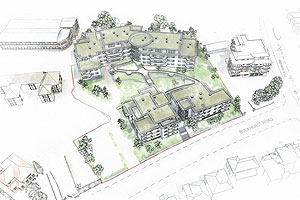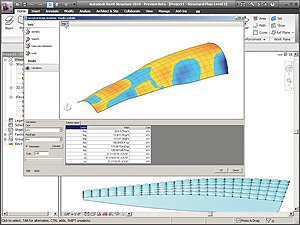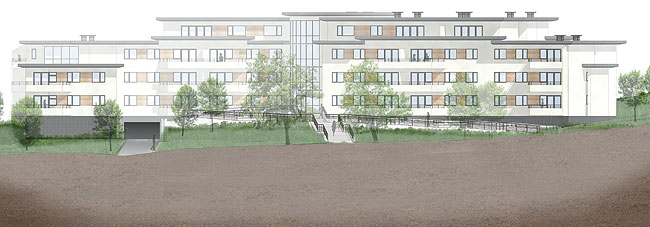Popular among students and professionals, McNeel Associate’s Rhino modelling tool is endemic in the architectural design world. The new Grasshopper environment provides an intuitive way to explore designs without having to learn to script, writes Martyn Day.
Generative modelling is undoubtedly becoming one of the most exciting CAD developments adopted by the industry. While architectural practices lagged mechanical designer’s appetite for 3D by about 20 years, there has been a sharp increase in the use of 3D and advanced form-creation tools and Rhino is one of the more popular solutions.
Rhino has played a predominant role within that move to 3D because of its low cost, ease of use and powerful feature set. Bob McNeel, the man behind McNeel and Associates, developer of Rhino, estimates that it possibly has around 50,000 architectural users worldwide. However, Rhino is developed to be a non-industry specific surface modelling tool, at home designing a yacht, a ring, a shoe or a skyscraper it produces surfaces that are useful for all designers.
McNeel has developed a number of Rhino add-ons and plug-ins, mainly offering additional broad-functionality for rendering and animation in the guise of other animals ‘Penguin’ and ‘Flamingo’, as well as ‘Bongo’ and ‘Brazil’. The latest enhancement is called Grasshopper and comes free of charge while it is in development. Aimed at the emerging generative shape designers, Grasshopper is tightly integrated into Rhino and allows the user to interactively drive geometry via a plug and play interface, removing the need for learning the RhinoScript language.
Bob McNeel said that Grasshopper was developed as an attempt to make scripting more accessible to users that wanted generative modelling tools. “During the design process, designers set-up sophisticated relationships between the parts of the design problem. Before Grasshopper, Scripting, .NET, or C++ code was the only way to do that in Rhino. Writing code is not something designers really want to get their head into. It seemed like most bigger firms have a few ‘scripting geeks’ that could not keep up with the designers’ demands. So more and more designers were asking for scripting training… but then they hated it once they figured out how tedious coding was.
“Grasshopper is a way for designers to look at design problems as a set of sophisticated relationships and to map those relationships graphically and programmatically into a system that allows them to interactively play with alternatives. At first Grasshopper was very simple but, based on user feedback, it now allows for very complete systems, including the ability for expert users to extend the system with C# and Visual Basic components.”
Grasshopper works within Rhino and uses standard Rhino geometry but has its own slick interface window. Algorithms and manipulators are dragged, dropped and connected, as if they were being wired together like effects pedals. It is about as easy as it gets to use but still requires a methodology and understanding of geometry to get a desired result.
Rhino in London
Rhino is particularly popular with expressive London-based architects, such as Zaha Hadid, Buro Happold, HOK Sport and Foster + Partners. Fostering Grasshopper’s usage in London is SimplyRhino, the largest Rhino reseller.
The company runs the annual Shape to Fabrication event which focuses on the use of Rhino and Grasshopper in modelling forms and shapes, through to complex engineering analysis and final manufacturing. McNeel programmers and even Bob McNeel usually make an appearance and are very accessible. The Simply Rhino Shape to Fabrication events are always complete sell outs and well worth attending.

Globally, Bob McNeel knows of 12,000 active Grasshopper customers, 90% of which are architects but admits there may well be more as users do not have to register to download. This liberal attitude permeates through McNeel’s business model and means the company is very customer focussed, leading to a very active user community.
One of the stand-out messages from Grasshopper was McNeel linking the modelling to fabrication. While other CAD vendors seem to only concentrate on the modelling aspect in creating the 3D forms, McNeel has always talked about what happens once the design is complete. “Our assumption is that Rhino is all about ‘design for digital fabrication’. Rhino has always been about free-form shapes that are accurate enough to manufacture. Architecture is the only market we are in that still requires complete 2-D documentation. In all of the other markets, the Rhino 3-D model is used in all phases of design through to fabrication. In many cases without any 2-D documentation.
“AEC is only beginning to catch up. Many of the limitations are not related to the CAD technology, instead the problem is with the AEC business model where everyone is trying to protect themselves from being sued by the other members in the process. Lucky for us, free-form architecture has become very fashionable and it is not possible to fabricate those buildings from 2-D drawings alone. In general, I would guess that more than half of all Rhino users are on the fabrication side rather than the design side.”
Grasshopper is being used and talked about by the same people that had advanced geometry needs and bought into Bentley Systems’ Generative Components (GC). However, GC is script-based and requires training. It is also based on MicroStation, which has a parametric modeller, while Grasshopper uses a very visual plug and play interface to automate the scripting and is based on Rhino, which is a non-parametric surface modeller.

Bob McNeel admitted that the company does not know much about GC, “except that people tell us that it is harder to learn and use than Grasshopper. Since Grasshopper is very flexible, users can set up most any kind of relationship they like, so I guess you could say some of those relationships are parametric. But if the user wants to organise their generative model more like a script, it is more script-like. We are trying not to limit anyone’s shape generation process by forcing them to think about it in a certain way. In most cases, Grasshopper is instantly interactive when you change an input (geometry or parameter) or when you change the definition.”
Performance
One of the biggest limitations of all parametric modelling tools is performance, it is very easy to create a script that forces the computer to make thousands of calculations and slow down. The shipping 32 bit version of Rhino suffers from the 2GB RAM limit. To access 64 bit it is suggested moving to the ‘work in progress’ Rhino 5 builds that are available. Bob McNeel explained the strategies to limit performance degradation: “Our goal is for the generative process to be completely interactive. If you make any change to the Grasshopper definition or an input, you see the change instantly. Of course, as the definition gets more complex and the model larger, it slows down. There are options to not regenerate every time you make a change. Also, it is easy to ‘disconnect’ part of a definition while you are working on others.”
The Mac
McNeel has said that Rhino is available as a ‘work in progress’ for the Apple Macintosh and it may be some time before Mac customers will be able to use it. “Grasshopper is a .NET application. It is not clear how we will be able to get Grasshopper over to OSX. The Rhino for OSX is still in development and we haven’t addressed any of the issues related to plug-ins yet,” said Bob McNeel.
Conclusion
Rhino has always been an impressive modelling tool but with Grasshopper, it becomes a very powerful design exploration conceptualiser. The interface for developing the generative designs is worthy of an ‘ease of use’ prize and shames established products like Bentley’s Generative Components. However, users still need to know what they are doing and how to get what they want from the geometry mathematically. The amazing work of Grasshopper users speaks volumes.
While Grasshopper is currently free, it may incur a cost in future. “Grasshopper is still in development. It will be free to all Rhino users as long as it is in development… at least another year. We are not sure yet if at some point it will be an option, or included with Rhino, or a special version of Rhino, or there is a basic version with Rhino and a full version option! In any case, it will not be a financial burden to anyone that wants to use it,” said Bob McNeel.
McNeel has recently launched a new website for the Grasshopper community, which offers tutorials, a gallery and an active forum.
Price: Rhino £890






